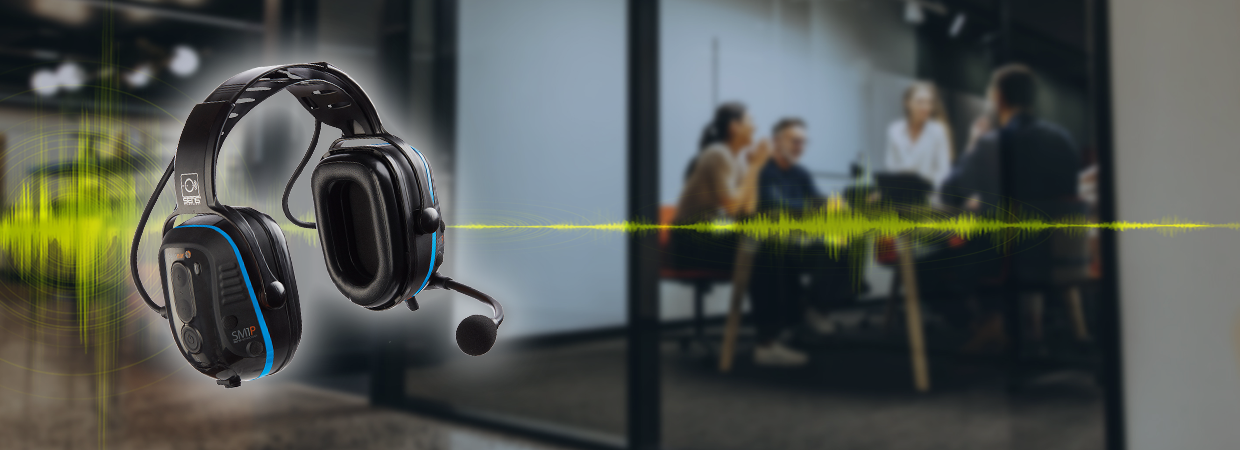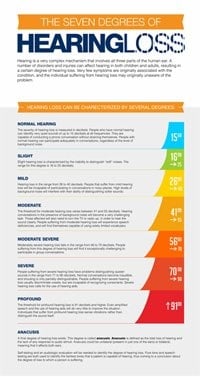- Home
- Blog
- Noise-Induced Hearing Loss
- The 7 Degrees of Hearing Loss


Hearing loss is a generic term that encompasses a wide range of issues and various degrees of disabilities. Typically, hearing loss can be a progressive process, often occurring subtly over time. If not taken seriously, hearing loss can leave uninformed workers in high-noise environments with permanent hearing impairments. Not only is this damaging for the worker, but this also affects the company or business owner greatly, as they can be held liable for the health and safety of their employees.
Employee safety must always be the top priority in the workplace. To effectively ensure the safety of employees, it is important to understand the characteristics of hearing loss and how it can start. Sensear’s infographic on the seven degrees of hearing loss provides detailed information about these characteristics.
Some Background Information on Hearing
Hearing is one of the five senses. Although we do not even have to think about how we hear, it is a complex process that your brain can normally process very quickly. Even before birth, infants respond to sounds. From birth, the human ear is a fully developed body part that responds to noises both faint and loud. The ability to hear is such an integral part of how we understand the world around us that even slight hearing loss can have a major impact on our daily lives.
The severity of the hearing loss is measured in decibels or dB for short. People with no hearing loss or normal hearing can identify noises as low as 15 dB(A), regardless of the level of background noise around them, and have conversations without needing to strain themselves. Once introduced to harmful noises, the thresholds start to rise – thus, introducing the seven degrees of hearing loss.
The Seven Degrees
All seven degrees of hearing loss can be caused by the same medical conditions, lifestyle factors, or injuries; however, the severity of hearing loss depends on the amount of exposure to significant levels of noise over different periods of time.
- NORMAL HEARING – People who have normal hearing can identify very quiet noises of up to 15 dB(A) at all frequencies.
- SLIGHT – Slight hearing loss is characterized by the inability to distinguish “soft” noises. The range for this degree is 16 - 25 dB(A).
- MILD – Hearing loss in the range of 26 - 40 dB(A). People who suffer from mild hearing loss will be incapable of participating in conversations in noisy places. High levels of background noise will interfere with their ability to distinguish softer sounds.
- MODERATE – The threshold for moderate hearing loss varies between 41 - 55 dB(A). Hearing conversations in the presence of background noise will become a very challenging task. Those affected will also need to turn the TV or radio up to hear the sound clearly. People suffering from moderate hearing loss will experience speech deficiencies and will find themselves capable of using solely limited vocabulary.
- MODERATE SEVERE – Moderately severe hearing loss falls in the range from 56 - 70 dB(A). People suffering from this degree of hearing loss will find it exceptionally challenging to participate in group conversations.
- SEVERE – People suffering from severe hearing loss have problems distinguishing quieter sounds in the range of 71 - 90 dB(A). Normal conversations become inaudible, and shouting is only partially distinguishable. These people can usually distinguish vowels but are incapable of recognizing consonants. Severe hearing loss calls for the use of hearing aids.
- PROFOUND – The threshold for profound hearing loss is 91 dB(A) and higher. Even amplified speech and the use of hearing aids will do very little to improve the situation. Individuals suffer from profound hearing loss since vibrations rather than distinguish the sound itself.
- ANACUSIS – A final degree of hearing loss exists and is called anacusis. Anacusis is defined as the total loss of hearing and the lack of any response to audio stimuli. Anacusis could be unilateral (present in just one of the ears) or bilateral, meaning that it affects both ears.
Symptoms of Hearing Loss
There are several symptoms of hearing loss that companies and employees should watch for:
- Frequently asking people to speak up or repeat themselves
- Difficulty hearing when sound sources are far away
- Difficulty understanding a conversation, especially in a group of people
- Difficulty hearing on the telephone
- Turing one ear toward a person or speaker to hear better
- Feeling that people mumble or do not speak clearly
- The presence of noise (ringing, humming, buzzing, etc.) in the ear(s) when no sound is present
- Denial
- Fatigue or stress
- Strained personal relationships
- Social withdrawal due to feelings of anxiety or tension
- Irritability
Loud noise is extremely detrimental to the proper functioning of the ear. The level, strength, and duration of the exposure can all impact hearing. Damaging sound levels are once again measured in decibels. Sounds of 150 dB(A) are described as extremely painful. Fireworks at three feet produce a sound of 150 dB(A). Jackhammers, jet plane takeoffs, and sirens are characterized as other “painful” sounds. To decrease the risk of hearing loss in such circumstances, individuals need to get in the habit of using the right kind of ear protection.
How SENS® Technology Can Help Manage a Noisy Work Environment
If your workplace environment is noisy, it is important to have the proper hearing protective devices (HPDs) for your employees. Sensear’s SENS® Technology in our Digital Communication Headsets suppresses noise in the surrounding environment while allowing users to still communicate with each other. Sensear is helping businesses across the globe effectively manage their noisy work environments to keep their employees safe, efficient, and productive.
SENS® works by limiting loud background noises while processing and separating speech, allowing the wearer to hear speech, alarms, or other important sounds. This is perfect for potentially dangerous environments such as factories, heavy industrial sites, etc. where workers need to be able to hear their coworkers yet require loud machinery noises to be suppressed. SENS® achieves this by using a high-tech sound filtration of built-in digital signal processing.
Use our Hearing Protection Calculator to calculate the sound level at the ear when wearing hearing protection. If your HPDs are not providing the correct level of hearing protection for your workers, choose the right hearing protection and prevent hearing loss. Contact us today for a free consultation to discuss your concerns, or download our Buyer’s Guide to Communication Headsets.









